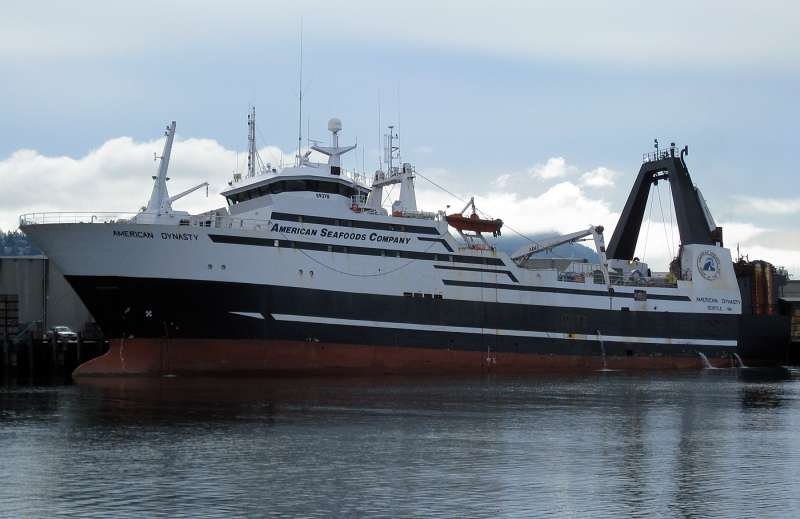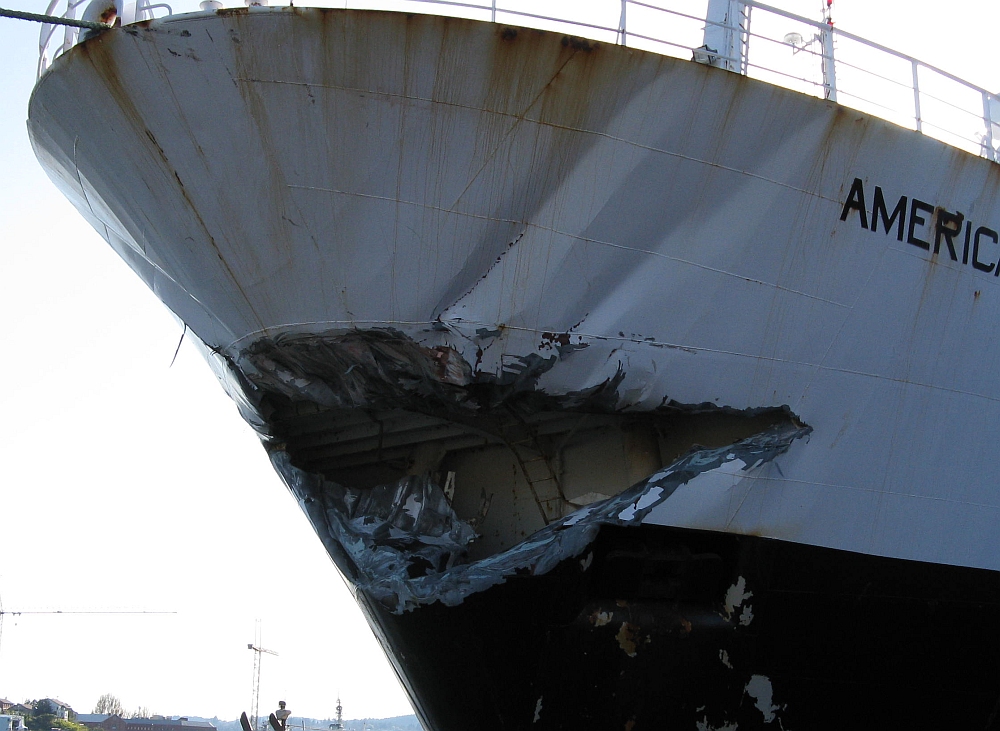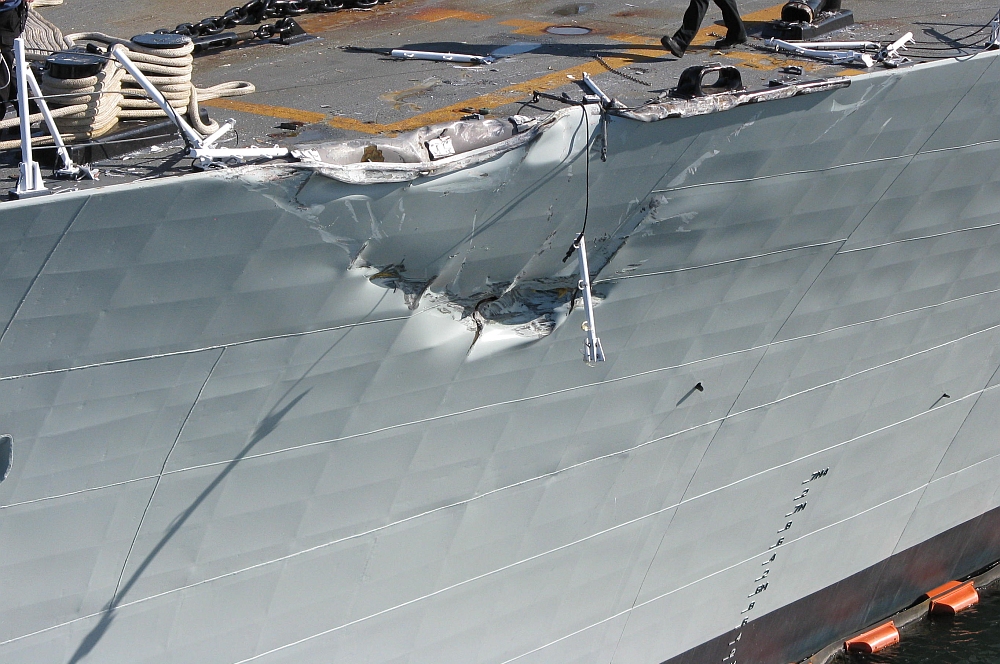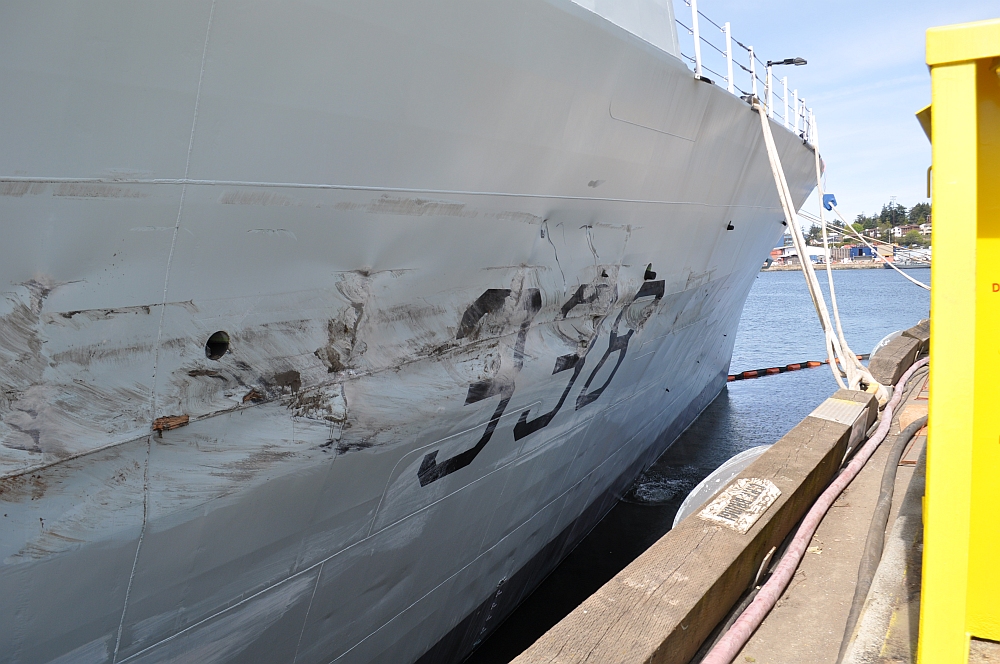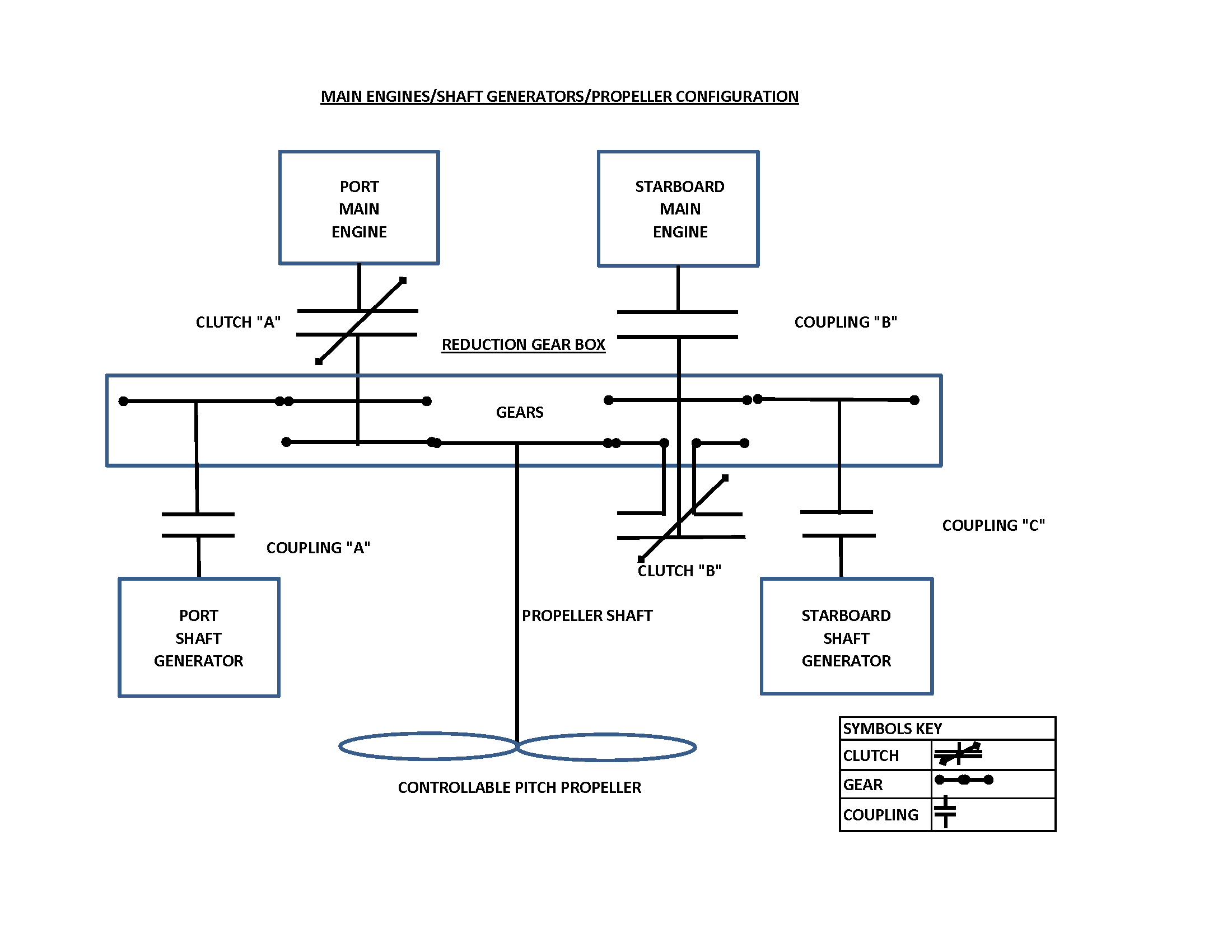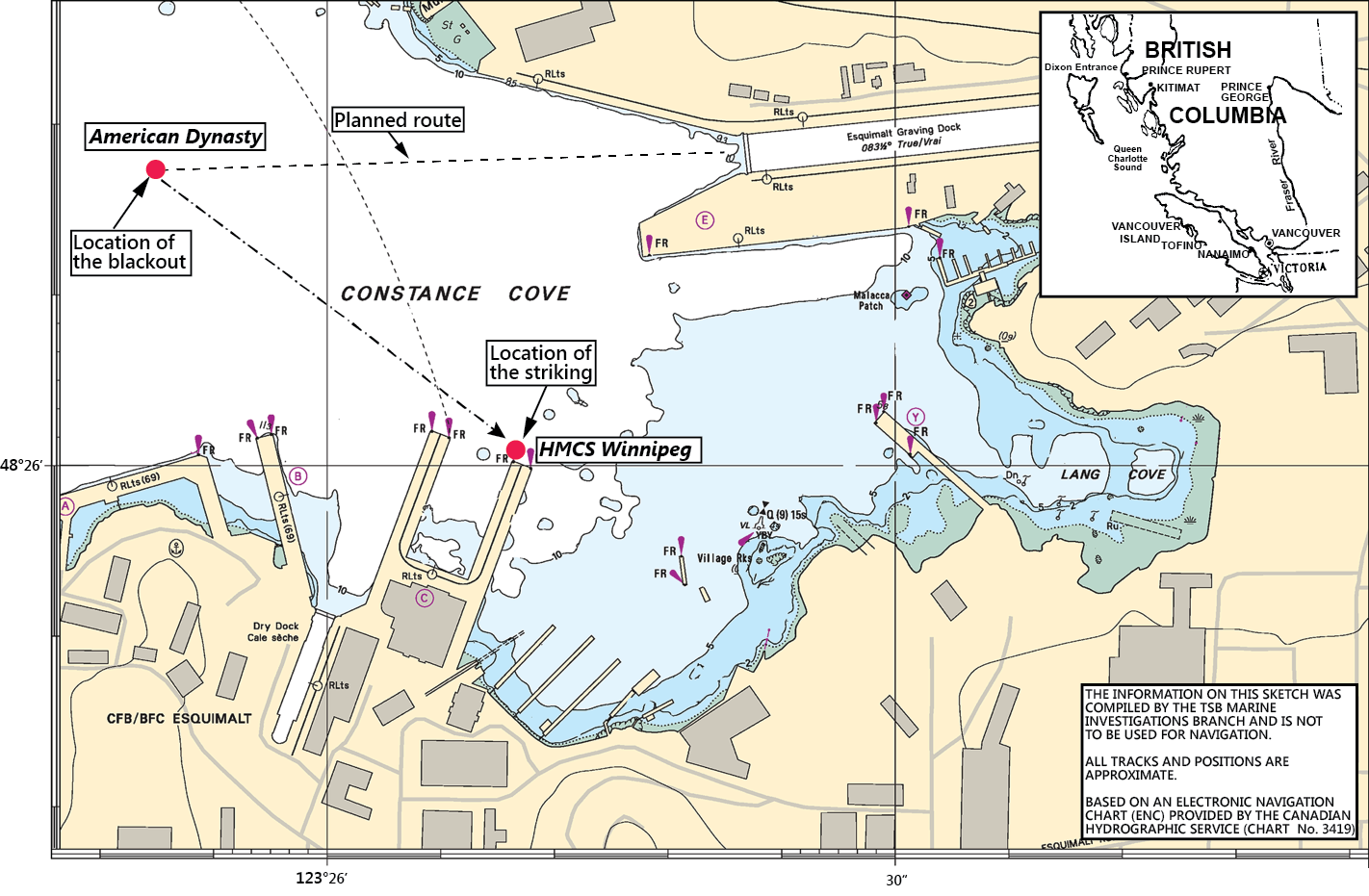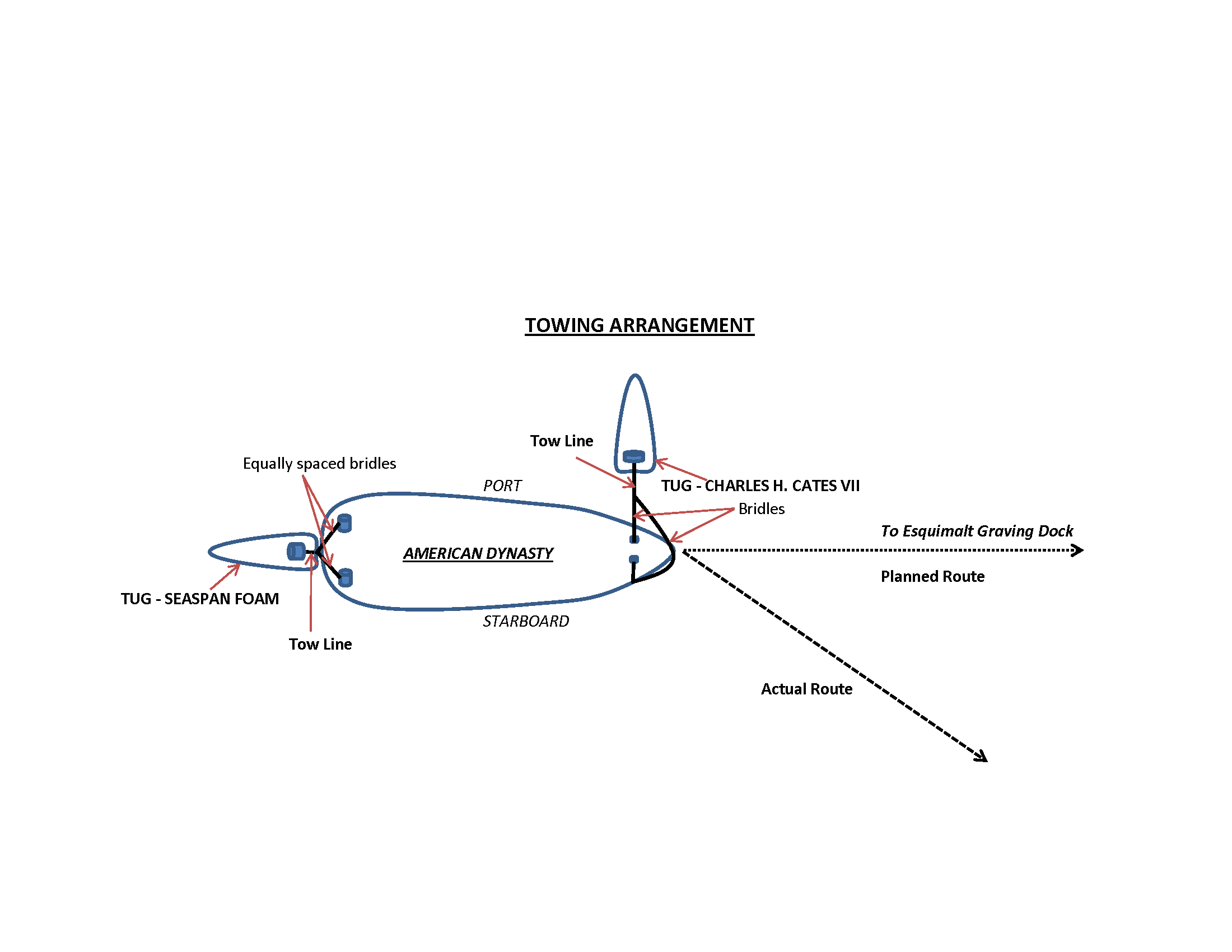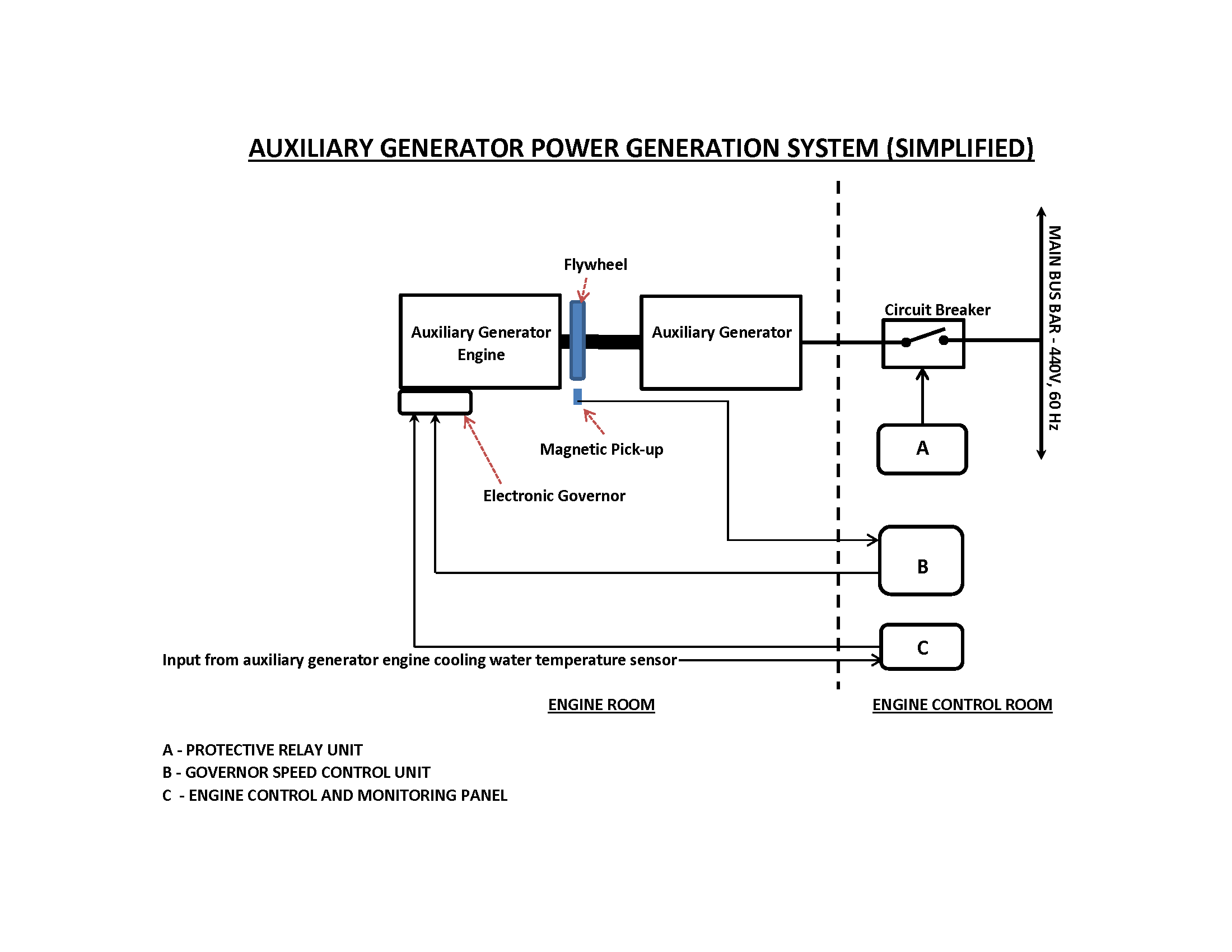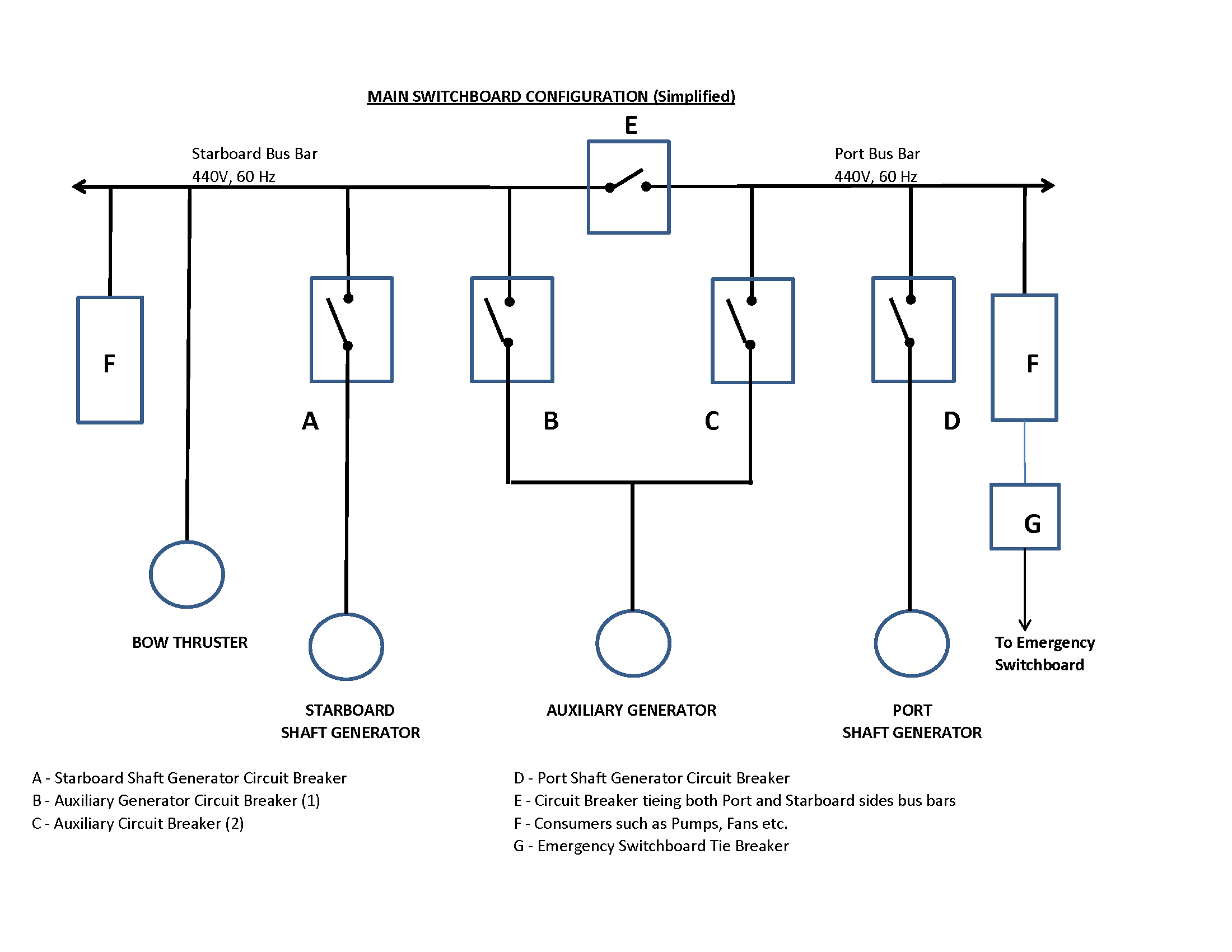Striking
HMCS Winnipeg
Fishing Vessel American Dynasty
Esquimault Harbour
Esquimalt, British Columbia
The Transportation Safety Board of Canada (TSB) investigated this occurrence for the purpose of advancing transportation safety. It is not the function of the Board to assign fault or determine civil or criminal liability. This report is not created for use in the context of legal, disciplinary or other proceedings. See Ownership and use of content. Masculine pronouns and position titles may be used to signify all genders to comply with the Canadian Transportation Accident Investigation and Safety Board Act (S.C. 1989, c. 3).
Summary
On 23 April 2013, at approximately 0818 Pacific Daylight Saving Time, the fishing vessel American Dynasty experienced a complete loss of electrical power (blackout) while approaching the graving dock in Esquimalt, British Columbia. The vessel was under the conduct of a docking pilot and was being assisted by 2 tugs at the time. Following the blackout, the American Dynasty gained speed to an estimated 5 knots, veered to starboard, and struck the HMCS Winnipeg, which was berthed nearby at the Canadian Forces Base Esquimalt. There was extensive damage to both vessels and minor injuries were sustained by 6 shipyard workers on the HMCS Winnipeg.
Factual information
Particulars of the vessel
| Name of vessel | American Dynasty | HMCSFootnote 1 Winnipeg |
|---|---|---|
| Official number | 7390428 | FFH 338 |
| Port of registry | Seattle | Ottawa |
| Flag | United States | Canada |
| Type | Factory stern trawler | Halifax-class patrol frigate |
| Gross tonnage/displacement | 3659 | 5000 |
| LengthFootnote 2 | 83 m | 134.1 m |
| Draught at time of occurrence | Forward: 4.88 m Aft: 4.88 m |
Forward: 4.9 m Aft: 4.9 m |
| Built | Houston, exas, U.S., 1975 | Saint John, New Brunswick, 1994 |
| Propulsion | 2 diesel engines (2940 kW), each developing a maximum of 750 rpm, driving 1 controllable-pitch propeller at 160 rpm | 2 gas turbines (25 060 kW each); 1 SEMT Pielstick diesel engine |
| Cargo | None | N/A |
| Maximum complement | 9 crew and 140 factory workers | 225 officers and non‑commissioned members |
| Registered owner and manager | American Seafoods Co., LLC | Government of Canada |
Description of the vessel
The American Dynasty is an ice-classed steel hulled vessel that was converted from an offshore tug/supply vessel to a factory stern trawler (Photo 1). The vessel is fitted with trawl gear and has been used in fishing operations since 1989. The bridge is located forward; the engine room, a controllable-pitch ducted propeller,Footnote 3 and a single flap-type rudder are located aft.
The bridge is equipped with 2 radars, 1 automatic identification system (AIS),Footnote 4 1 echo sounder, 2 GPSs, 4 rudder indicators, and a console for the global maritime distress and safety system. It is also fitted with an internal communications system that includes a main telephone system powered by the vessel's electrical system, a sound-powered telephone,Footnote 5 and hand-held radios.
Propulsion is provided by 2 main enginesFootnote 6 that drive the controllable‑pitch propeller. The propeller shaft turns in a counter-clockwise directionFootnote 7 and is connected to the engines through a reduction gearbox that reduces the engines' rpm from 750 to 160. The vessel has 2 shaft generatorsFootnote 8 that are connected to the main engines through the same reduction gearbox. The port main engine is coupled to the propeller shaft and the port shaft generator through a clutch; the starboard main engine is also coupled to the propeller shaft through a clutch but directly drives the starboard shaft generator (Appendix A). The vessel is fitted with an emergency diesel generator and an auxiliary diesel generator for supplying electrical power. The vessel also has a 380 kW electric bow thruster.
History of the voyage
The American Dynasty was scheduled to undergo a mandatory quadrennial dry‑docking starting 23 April 2013 in the graving dockFootnote 9 in Esquimalt, British Columbia (Appendix B). On 22 April, in Seattle, Washington, a crew of 9 prepared the vessel to depart. At 1950,Footnote 10 the chief engineer started both main engines and the masterFootnote 11 conducted pre-departure control tests of all bridge equipment. Given the time and proximity of the vessel to residential buildings, the whistle was not tested.Footnote 12 The master made contact with the regular master by telephone to obtain information about changes to bridge equipment, as was his normal practice.
At 2100, the chief engineer transferred the vessel's propulsion controls to the bridge and the vessel departed at 2205. Soon after, the United States Coast Guard (USCG) observed that the vessel's AIS was not transmitting and advised the master. The master consulted with the chief mate and then telephoned the regular master for assistance with the AIS. The regular master referred the master to the instruction manual and, after consulting the manual, the master enabled the transmitting mode.
At 0710 on 23 April, the vessel reached the pilot station off Ogden Point, where a BC Coast pilot boarded and exchanged pertinent informationFootnote 13 with the master. An apprentice pilot, who was training with the BC Coast pilot, also boarded the vessel. The pilot then ordered a course for the graving dock and the vessel proceeded toward Constance Cove (Appendix B) with the pilot, the apprentice pilot, and the master on the bridge: the first mate had retired to the vessel's office to complete administrative duties and the 2 deckhands were on deck.
At 0735, the master set the pitch control for the controllable‑pitch propeller to zero.Footnote 14 While waiting for the tugs to arrive,Footnote 15 the master used the bow thruster to align the vessel's bow with the entrance to the graving dock. Meanwhile, the oiler and the chief engineer transferred fuel oil between tanks and filled the forepeak tank to trim the vessel.Footnote 16
At 0805, the tug Seaspan Foam transferred the docking pilot and the docking crew to the American Dynasty before making fast on the vessel's stern; at the same time, the tug Charles H. Cates XX made fast to both port and starboard bow (Appendix C). After boarding, the docking pilot exchanged information with the BC Coast pilot and then took charge of the vessel, requesting that the master shut down the radars and both main engines.Footnote 17
At approximately 0815, the master switched off the radars and then telephoned the engine control room. He advised the oiler, who answered the telephone, that he was going to transfer propulsion control and then hung up. The oiler had answered the telephone as the chief engineer was in the washroom on the main deck when the master called. At approximately 0816, the master transferred control to the engine control room. The oiler had never accepted control before, so he asked the electrician, who was also in the engine control room, about the procedure for accepting control. The electrician responded that accepting control was done by pressing the transfer button on the propulsion control panel. The oiler pressed the transfer button and then left the engine control room to stop the fuel oil transfer. Both of the main engines remained clutched in and were turning the propeller shaft. The propeller pitch remained at zero.
After confirming the control transfer, the master switched off both steering gear pumpsFootnote 18 and the bow thruster motor. At this time, the tugs were towing the vessel toward the graving dock at a speed of 1.6 knots. Approximately 15 seconds after the transfer of control, the vessel sustained a complete loss of electrical power about 750 m from the graving dock (Appendix B). The emergency generator did not start automatically.
The oiler and chief engineer immediately returned to the engine control room, where the chief engineer observed that the circuit breaker on the main switchboard had tripped. This meant that electrical power was not available even though the auxiliary generator engine was still running. The chief engineer tried to put the auxiliary generator back on the main switchboard by means of push buttons on the breakers, but the breakers did not engage. The chief engineer also noticed that the propulsion control panel was off.Footnote 19
Shortly after, the BC Coast pilot observed that the vessel was turning to starboard and gaining speed and warned the master. The vessel was on a track towards the HMCS Winnipeg, which was berthed at pier 3C at Canadian Forces Base (CFB) Esquimalt (Appendix B).Upon noticing propeller wash, the master attempted to call the engine room using the main phone, but the line was dead. The master then requested the first mate to go to the engine room and assess the situation. By this time, the American Dynasty was approximately 400 m from the HMCS Winnipeg.
After noticing the vessel gaining speed and turning to starboard, the master on the Seaspan Foam paid out the tug's entire tow line while attempting to slow and realign the American Dynasty by pulling it astern. However, the American Dynasty continued to speed up and the brake lining on the tug's winch disintegrated. Meanwhile, the master on the Charles H. Cates XX tried twice to realign the American Dynasty by pulling on the tow line from the port side, but during both attempts the tug girded. The master on the Charles H. Cates XX made a final attempt, but the tow line bridles parted and the American Dynasty continued to speed up on its track toward the HMCS Winnipeg.
Meanwhile, the chief engineer, who was not aware that the vessel was speeding up and veering to starboard, made several attempts to restore power to the vessel using the push buttons on the breakers. While attempting to engage the circuit breaker manually, the auxiliary generator engine shut down automatically and the chief engineer left the engine control room to investigate the cause.
As the vessel neared the HMCS Winnipeg, the master ordered that the anchor be dropped; the master also tried to sound the whistle, but it did not function. When impact with the HMCS Winnipeg became imminent, the attempt to drop the anchor was aborted.
At approximately 0818, the bow of the American Dynasty struck the port side of the HMCS Winnipeg approximately 7 m abaft its stem, at a relative angle of 145° and an estimated speed of 5 knots. The American Dynasty's forepeak tanksplit open, discharging ballast water onto the bow of the HMCS Winnipeg. Just after the impact, the chief engineer manually set the fuel pump rack to the “no fuel” position, which shut down the port main engine. At that time, the chief engineer observed that the starboard engine had already shut down.
Following the striking, the American Dynasty remained embedded in the HMCS Winnipeg until a preliminary assessment of damageFootnote 20 to both vessels was conducted. With the assistance of tugs, the American Dynasty was separated from the HMCS Winnipeg at around 1710, at which time the American Dynasty proceeded under tug escort to the lay berth at the Victoria Shipyards, located adjacent to the graving dock. The HMCS Winnipegremained alongside pier 3C at CFB Esquimalt.
Injuries
Six shipyard workers on the HMCS Winnipeg were treated for minor injuries.
Damage to the vessels
American Dynasty
The vessel primarily sustained damage to the bow (Photo 2). The shell plating between the main deck and forecastle deck was pushed inward from stem to approximately frame 3B portside and 4A starboard side, splitting open the forepeak tank. The port bow shell plating between forecastle deck 1 and forecastle deck 2 was buckled from frame 5 to frame 4B, as was the deck plating in the forward store. The starboard bow shell plating was buckled between the same decks from frame 5 to frame 3.
Internals in the chain locker space (from the stem to the anchor pocket plating on the port and starboard sides) were deformed. The upper forward corner of the port anchor pocket was also deformed.
HMCS Winnipeg
The vessel primarily sustained damage to the bow. The port side shell plating was punctured between frames 1.5 and frame 3, and the associated longitudinals and web frames were damaged (Photos 3 and 4).
Local buckling of decks and bulkheads in the immediate vicinity of the impact also occurred. The starboard side shell plating sustained punctures and dents and some of the associated longitudinals and web frames were damaged. The starboard stern corner was deformed, as were the associated longitudinals and tripping brackets.
The transverse watertight bulkhead at frame 12 was buckled, as was the bulkhead at frame 18. An underwater survey carried out by divers indicated scrapes and damage to the stern flap on the starboard side.
Seaspan Foam and Charles H. Cates XX
The following parts of the Seaspan Foam's towing winch sustained damage: the brake bands, fairlead, spooling gear rollers, clutch, and power take-off. The tug's bridles and tow line were also damaged. The tow line on the Charles H. Cates XX was severed into 2 pieces.
Damage to shore facilities
Damage to the naval dockyard was as follows:
- Pier 3C sustained damage to 6 sections of timber guards and galvanized steel brackets. The front top corner of the concrete wharf deck was sheared over approximately 12 m, and 5 sections of fender timbers at the top of the fender wall were damaged.
- The kiosk on pier 3C sustained structural damage and was displaced 75 to 100 mm as a result of the impact. Nine of the 10 anchor bolts were sheared off. Various types of piping (steam, air, grey water, sanitary, fire, and oily water) in the kiosk were damaged.
- The concrete float was holed and the roller guide assemblies sustained damage, as did the float timber rub rail. The float bull rail brackets were bent at the time of impact.
Personnel certification and experience
Master
The master held a Merchant Mariner Credential issued by the USCG and was limited to serving as a master on uninspected fishing vessels of not more than 5000 gross registered tons (GRT). The master began his employment with the American Seafoods Company in 2000 and, since then, had served as a master on the American Dynasty for a combined total of about 90 days. The master had also served as a relief mate/relief master on other company vessels.
First mate
The first mate held a Merchant Mariner Credential issued by the USCG and was limited to serving as a first mate on uninspected fishing vessels of not more than 5000 GRT. The first mate had held this position with the American Seafoods Company since 1995, and had worked on the American Dynasty since 2012.
Chief engineer
The chief engineer held a Merchant Mariner Credential issued by the USCG and was limited to serving as a chief engineer on motor vessels of any horsepower. The chief engineer had been employed as an engineer with the American Seafoods Company since 1998 and had been a chief engineer on the American Dynasty since 2010.
Tug masters
The master of the Seaspan Foam held a Master 350 Gross Tonnage Near Coastal certificate issued by Transport Canada (TC) and had been employed as a master since 1976. The tug master regularly assisted vessels into the Esquimalt graving dock.
The master of the Charles H. Cates XX held a Master 350 Gross Tonnage Near Coastal certificate issued by TC and had been employed as a master since 1993. The tug master regularly assisted vessels into the Esquimalt graving dock.
Vessel certification
The American Dynasty was registered under the U.S. flag and certified accordingly by the USCG and the classification society Det Norske Veritas for the trade in which it was employed.
Environmental conditions
The weather around the time of the occurrence was clear. The visibility was good and the wind was from the northeast at 6 km/hr. At the time of the occurrence, the tide was ebbing and was recorded as 1.1 m.
Main power generation
On the American Dynasty, main electrical power can be provided by either the shaft generators, the auxiliary generator,Footnote 21 or all 3 simultaneously. At the time of the occurrence, the auxiliary generator was in use. The auxiliary generator is driven by a diesel engine that is fitted with a protective relay unitFootnote 22 as well as an engine control and monitoring panel that can be used to check engine parameters such as the engine cooling water temperature (Appendix D).
The engine also has an electronic governor with a speed control unit that is used to control and maintain a constant engine speed. The speed control unit receives signals from a magnetic pick-upFootnote 23 and these signals are used to regulate engine speed. The speed control unit is designed to shut the engine down if the magnetic pick‑up fails.
Post-occurrence, the face of the magnetic pick-up was found to be damaged. In addition, the auxiliary engine's speed sensing failsafe unit (located inside the electronic governor's speed control unit) was found to be bypassed by a jumper wire. Bypassing the speed sensing failsafe unit would deactivate the failsafe circuit and would prevent the engine from shutting down.
Emergency power generation
The emergency generatorFootnote 24 on the American Dynasty powers the essential systems necessary for the safe operation of the vessel. The emergency generator has a selector switch that can be used to set the generator to either off/reset, manual, or automatic. For the emergency generator to start automatically in the event of power loss, the selector switch must be set to automatic. In port, when shore power was not available, the practice was to use the emergency generator as a harbour generator. This required the selector switch to be set to manual. Prior to the occurrence, the vessel had been docked in Seattle, where the emergency generator was being used as a harbour generator. When the vessel departed for the Esquimalt graving dock, the selector switch was in the off/reset position.
The vessel is fitted with 3 sets of 24 V direct current (DC) batteries that are designed to automatically begin supplying power to several of the vessel's essential systems (including the propulsion pitch control system and the main engine systems) in the event of power loss. The vessel also has a separate set of 12 V DC batteries to ensure a continuous power supply to several pieces of equipment on the bridge in the event of power loss. These batteries are charged by the vessel's main electrical system.
The vessel had a battery log to keep track of tests on the emergency batteries. Testing of the batteries had been previously conducted by various crew members but did not follow an established schedule. All of the vessel's batteries had last been replaced in 2009. At the time of the occurrence, the batteries did not function as intended to power the vessel's essential systems.Footnote 25
Power distribution
The distribution of power from the generators to the various systems on the American Dynasty is controlled by the main switchboard, which is located in the engine control room. Under normal circumstances, to put one of the vessel's generators on the main switchboard, a rotary synchroscopeFootnote 26 needs to be manually adjusted to synchronize the phase rotation, after which time the circuit breaker for that generator can be engaged. At the time of the occurrence, the auxiliary generator was supplying the electrical power required for the safe navigation of the vessel. As such, additional power from both shaft generators was deemed unnecessary and the shaft generators, though running, were not put on the main switchboard (Appendix E).
The emergency switchboard is located on the main deck and supplies power to the emergency fire pump, steering gear motor No. 2, starting air compressor No. 2, and other essential circuits. In normal operating conditions, the emergency switchboard receives power from the main switchboard. In the event of power loss, the emergency switchboard can be powered by the emergency generator, which would automatically start if the selector switch was set to the automatic position.
Propulsion control system
Propeller pitch control is required to maintain a vessel's direction and speed. On the American Dynasty, the pitch on the propeller was controlled via a hydraulic system that included an oil distribution box and an actuator. In response to the operator's input at one of the vessel's propulsion control stations, the actuator would set the degree of pitch and the oil distribution box would direct a corresponding amount of oil to flow into either the ahead or astern ports, thereby controlling the degree of pitch on the propeller.
Under normal conditions, an operator could set and monitor the propeller pitch from one of the 4 propulsion control stations located on the bridge or from the single propulsion control station located in the engine control room.Footnote 27 In the case of complete power loss, the propeller pitch could be controlled manually using the local pitch control near the oil distribution box.Footnote 28 However, before the local pitch control could be operated manually, a switch on the emergency propulsion control station needed to be set to local.
Post‑occurrence tests conducted by Rolls-Royce service technicians on the propulsion control system indicated that, when the actuator was not powered,Footnote 29 the pitch would creep in the ahead direction. Tests on the actuator (when it was not under power) found that defects within the actuator assembly and internal leaks in the oil distribution box allowed hydraulic oil to flow in the ahead port, inducing the pitch to move approximately 55%.
Post-occurrence tests also indicated that once the propeller shaft was clutched in, electrical power was needed to de-clutch.
The oil distribution box had last been overhauled in 2002. The original equipment manufacturer (OEM) specifications recommended that the oil distribution box be overhauled once every 80,000 operating hours. The oil distribution box and associated equipment were scheduled to be overhauled during the 23 April 2013 dry-docking.
Management of safety
The principal objective of a safety management on board vessels is to ensure safety at sea, prevent human injury or loss of life, and avoid damage to property and the environment. Safety management involves individuals at all levels of an organization and requires that a systematic approach is taken in the identification and mitigation of operational risks. One aspect of safety management on board vessels is ensuring crew familiarization, whereby all crew members receive orientation on vessel arrangements, installations, and equipment, with an emphasis on the crew members' specific duties, particularly those related to their tasks in cases of emergency.
The vessel complied with the requirements set out by the USCG and had a training regime and drills for fire, abandon ship, man overboard, and unintentional flooding situations. The regular master had created bridge standing orders for certain on-board emergencies. These included situations where the vessel sustained a loss of steerage, loss of propulsion, loss of electrical power, or required emergency towing by another vessel. Also, the engine room had procedures for synchronising the generators as well as routing power to the main switchboard under normal circumstances.
The vessel did not have documented procedures for dry-dockings. The engine room did not have documented procedures for managing emergencies such as loss of power or loss of remote pitch control, and the vessel did not carry out blackout drills.
Maintenance management system
A maintenance management system is a paper or software-based system that can assist vessel owners and operators in carrying out methodical and timely inspections and maintenance. Such a system can be used to establish maintenance and inspection intervals and to define the methods for maintenance tasks; in addition, it can be used to assign responsibility for maintenance to appropriate qualified personnel.
The American Dynasty had a computerized planned maintenance system on board; the company had access to the system as well. The planned maintenance system was used to order spare parts and store items. The company primarily used the classification society's continuous machinery surveysFootnote 30 to determine on‑board maintenance requirements. The functions of the system associated with planning maintenance intervals, defining the methods and frequency for maintenance, and assigning responsibility for maintenance were not fully utilized.
Additional observations
Following the occurrence, the investigation found that the rudder angle indicator in the steering compartment and one of the indicators on the bridge were indicating 2.5° to starboard. The bow thruster indicator on the bridge was also found to be indicating approximately 10° pitch to starboard.
Analysis
Events leading to the striking
As the American Dynasty was being towed toward the graving dock at Esquimalt, the master set the propeller pitch to zero and then transferred both main engine controls to the engine room, but had not communicated the need to shut them down. As such, both main engines were left clutched in and the propeller shaft continued to turn. Shortly after the blackout, the propeller pitch crept ahead and the vessel began to speed up and veer to starboard. The tugs attempted to slow and realign the vessel but were unsuccessful because the tow lines parted. Without power, the bridge team had no means by which to control the propulsion and steering. The engine room was not alerted to the developing situation and was not aware that the vessel was speeding up, as the propulsion control panel that normally displays the engine parameters and propeller pitch had also blacked out. As such, the chief engineer was focused on restoring power and did not make use of the local pitch control. The vessel continued on its path and struck the HMCS Winnipeg.
Blackout
Although the exact reason for the blackout could not be determined,Footnote 31 the most likely cause was a damaged magnetic pick-up of the auxillary generator speed control unit. This damage resulted in the intermittent transmission of signals from the the magnetic pick‑up to the speed control unit. The speed sensing part of the control unit was also bypassed by a jumper wire.Footnote 32 When this part of the control unit is bypassed, it is unable to shut down the engine if the magnetic pick‑up is malfunctioning, allowing fluctuations in the electrical frequency to occur. Furthermore, when the bow thruster motor was switched off, a large load was suddenly taken off the auxillary generator, which may have caused the frequency to fluctuate above the maximum limit of the protective relay unit.
In this occurrence, the electrical frequency likely fluctuated above the maximum limit of the protective relay unit, causing the breaker to trip and the vessel to black out.
Restoring electrical power
Following the blackout, the emergency generator did not start automatically because the selector switch was set to off. The chief engineer's attempts to restore electrical power were unsuccessful, most likely because the synchroscope was not in the appropriate position and/or the protective trips were not reset. Furthermore, the auxiliary generator engine shut down shortly after these attempts, preventing the chief engineer from being able to restore power in a timely manner. The investigation determined that, following the blackout, the temperature of the cooling water in the auxiliary generator's engine cylinder rose 5°C because the temperature was not being regulated;Footnote 33 this was because the sea water pump stopped functioning after the blackout. Without sea water available to cool the engine cylinder water, and with the generator engine running at its rated rpm, the auxiliary generator engine likely shut down when the temperature of the cooling water reached the shut down temperature of 95°C.
Vessel's increase in speed
The back-up batteries did not hold sufficient charge to power the vessel's propulsion and pitch control systems; as such, without power, the actuator started creeping in the ahead direction, even though the degree of pitch on the propeller was set at zero. As a result, oil was directed into the ahead port, causing the propeller to generate thrust in the ahead direction. At the same time, the tugs were towing the American Dynasty at a speed of 1.6 knots, which generated hydrodynamic forces as water flowed over the propeller blades. These hydrodynamic forces, in conjunction with the inactive actuator, further increased the degree of pitch on the propeller and drew more hydraulic oil from the oil distribution box into the port. The propeller's pitch increased further and the vessel progressively sped up. Without electrical power, the propulsion control system did not provide a pitch deviation alarm to alert crew members that the pitch was moving in the ahead direction, nor could the pitch be monitored on the propulsion control display system, as it had blacked out.
Turn to starboard
The exact cause of the vessel's turn to starboard could not be determined; however, it may have been initiated by a combination of the 2.5° angle to starboard on the rudder and the 10° pitch to starboard on the bow thruster. Although the bow thruster had been turned off approximately 15 seconds prior to the blackout, it may have continued to create residual thrust to starboard before stopping completely, and this residual thrust may have added to the vessel's rate of turn.
Management of safety
Effective management of safety requires individuals at all levels of an organization to be actively involved in the identification and management of risks involved in their operation. While not all organizations are required to have formal safety management systems in place, it is nonetheless important that such organizations work towards the development of a strong safety culture,Footnote 34 whereby integral components of safety are managed to mitigate risk. In this occurrence, there were indications that aspects of safety associated with emergency preparedness and crew familiarization were not managed effectively:
- The master was not adequately familiarized with emergency bridge equipment. In the limited time prior to the striking, the master did not recall that the sound‑powered telephone was on the bridge. Furthermore, he was not aware that the hand-held radios could be used to contact the engine room.
- The engine room did not have documented emergency procedures to follow in case of a blackout and did not carry out associated drills. The chief engineer therefore did not have a systematic method by which to restore electrical power following the blackout.
- The vessel did not have documented procedures for dry‑docking, and in the chief engineer's absence, the oiler was not familiar with the procedure for accepting propulsion control from the bridge during a dry‑docking. When the oiler accepted propulsion control, he was not aware that the main engines were to be shut down and so left them clutched in.
- The engine room did not have a procedure to ensure that the emergency generator was set to start automatically in the event of power loss. The vessel departed Seattle with the selector switch on the emergency generator in the off position, disabling its ability to start automatically.
- The engine room did not have documented procedures for loss of remote pitch control, nor did they conduct associated drills.
Crew members who have not been adequately familiarized with a vessel and its equipment may not have the knowledge necessary to perform their duties. Furthermore, without procedures and comprehensive drills for emergency situations, crews may not be proficient in taking mitigating action during an emergency.
Vessel maintenance
A well-designed and systematic maintenance program is integral to the safe operation of any vessel. As part of the maintenance program, it is important that vessels have clearly documented maintenance procedures to ensure that inspections and repairs are carried out as required by designated individuals. A maintenance management system, such as the one on board the American Dynasty, is a useful tool to help owners and operators ensure that a vessel's equipment and systems are maintained in optimum working condition.
While the American Dynasty had a computerized planned maintenance system on board, it was not used to its full extent to manage vessel maintenance. As such, maintenance for some of the safety-critical equipment on the American Dynasty, such as the back-up batteries and the whistle, did not follow an established schedule to ensure regular testing and servicing. At the time of the occurrence, the 2 sets of batteries responsible for supplying power to the propulsion and pitch control systems did not hold sufficient charge to power these systems. Without an established battery maintenance schedule, batteries may not function as intended to power the vessel's essential systems. In addition, the whistle was not tested before the vessel left Seattle; in any event, it was not available due to the blackout.
Furthermore, the company primarily used the classification society's continuous machinery surveysFootnote 35 to determine on-board maintenance requirements. While the classification society tests equipment to determine if it is to class standards, this does not take into account original equipment manufacturer (OEM) recommended maintenance schedules. On the American Dynasty, the oil distribution box was found to have internal leaks and the actuator had defects that allowed hydraulic oil to leak into the ports. The oil distribution box was last overhauled in 2002; however, the OEM recommended that the oil distribution box be overhauled once every 80,000 operating hours. The oil distribution box and associated equipment were scheduled to be overhauled during the 23 April 2013 dry-docking.
If planning of maintenance intervals, defining the methods and frequency for maintenance, and assigning responsibility for maintenance are not carried out, there is an increased risk that required timely maintenance and inspections of all critical equipment may not be carried out, thereby compromising the safety of the vessel, its personnel, and the environment.
Findings
Findings as to causes and contributing factors
- The crew members were not familiarized with the vessel and its equipment.
- After engine control was transferred, both main engines remained clutched in and the propeller shaft continued to turn, as the master had not communicated the need to shut down the main engines.
- The vessel experienced a complete loss of electrical power as it was being towed towards the graving dock; the power loss was most likely caused by a damaged magnetic pick-up.
- Neither the emergency generator nor the back-up batteries provided emergency power; the bridge team, therefore, had no means by which to control the vessel's propulsion and steering.
- The loss of electrical power to the actuator valve, the internal oil leak from the oil distribution box, and the hydrodynamic forces acting on the propeller blades caused the pitch to creep in the ahead direction and the vessel's speed to increase.
- A combination of the 2.5° rudder angle to starboard and the 10° bow thruster pitch to starboard most likely caused the vessel to veer to starboard on a path towards the HMCS Winnipeg.
- The bridge did not make contact with the engine room after the blackout, but used available alternate means of communication. As a result, the chief engineer was unaware of the need to take action to prevent the American Dynasty from striking the HMCS Winnipeg.
- The vessel continued on its path and struck the HMCS Winnipeg.
Findings as to risk
- Without procedures and comprehensive emergency drills, crews may not be proficient in taking mitigating action during an emergency.
- If planning of maintenance intervals, defining the methods and frequency for maintenance, and assigning responsibility for maintenance are not carried out, there is an increased risk that required timely maintenance and inspections of all critical equipment may not be carried out, thereby compromising the safety of the vessel, its personnel, and the environment.
Safety Action
Safety action taken
Subsequent to the blackout and the striking, American Seafoods Company LLC took the following measures:
- Posted an operating procedure to ensure that the emergency generator is set to start automatically;
- Replaced the non-functional set of emergency back-up batteries;
- Replaced the magnetic pick-up sensor and governor speed control unit;
- Tested the auxiliary generator engine for all alarms and tripping functions;
- Overhauled the pitch control oil distribution box; and
- Replaced the pitch control actuator.
Pitch control testing was then carried out at all bridge control stations as well as the local engine control station. In all cases, pitch control operated as intended. Additionally, pitch control testing was carried out by intentionally causing a blackout, allowing the emergency generator to start automatically and supply emergency power after approximately 20 seconds. During the transition to emergency power, the 24V DC batteries continuously supplied back-up electrical power to the system. In all cases, the pitch held steady at the last commanded setting.
Following the occurrence, Rolls-Royce has installed a larger pitch control actuator valve with an increased holding force and resistance against uncontrolled pitch movement in the event of a total electrical failure.
This report concludes the Transportation Safety Board's investigation into this occurrence. The Board authorized the release of this report on . It was officially released on .
